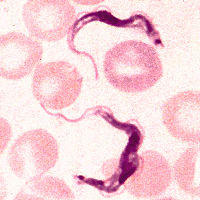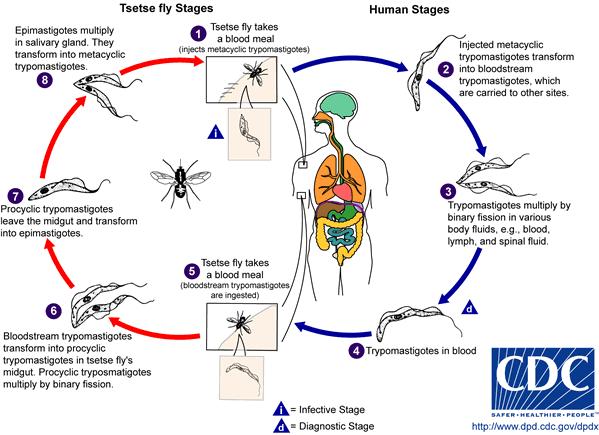Trypanosoma brucei
Articles that lack this notice, including many Eduzendium ones, welcome your collaboration! |
| Trypanosoma brucei | ||||||||||||||
|---|---|---|---|---|---|---|---|---|---|---|---|---|---|---|
 | ||||||||||||||
| Scientific classification | ||||||||||||||
| ||||||||||||||
| Binomial name | ||||||||||||||
| Trypanosoma brucei |
Description and significance
Trypanosoma brucei is a unicellular parasitic organism with no true tissues. It belongs to the protista kingdom and therefore has cell structures that are similar to the cells of many eukaryotes. T. brucei has no definite shape, it is mobile and has a single flagellum for locomotion.
T. brucei is often found in the rain forests and savannas with tropical climate. It is the cause of the disease trypanosomiasis, also called the African sleeping sickness. There are approximately 50,000-70,000 cases of trypanosomiasis found in Western and Central Africa.
Genome structure
Describe the size and content of the genome. How many chromosomes? Circular or linear? Other interesting features? What is known about its sequence? Does it have any plasmids? Are they important to the organism's lifestyle?
Cell structure and metabolism
T. brucei has organelles including endoplasmic reticulum, golgi apparatus, lysosome, nucleus, and a large mitochondrion. Its mitochondrion houses a unique structure called kinetoplast, where DNA is located. The kinetoplast is associated with the flagellum through microtubules. The organism has a flagellar basal body found posterior to the nucleus. The base of the flagellum is associated with the kinetoplast in the single large mitochondrion. The basal body plays a role in organizing spindles during mitosis.
Because of its animal-like cells, T. brucei has heterotrophic cells that require organic molecules for its source of energy. Studies have shown that it possesses some forms of energy producing enzymes. The organism acquires proline as a major energy source when it lives inside the gut of the tsetse fly. Since there is not much nutrients to be obtained from the gut of an insect, the parasite’s mitochondrion needs to carry out some type of metabolic pathways in order to generate sufficient energy. On the contrary, when nutrients become more abundant in mammalian host, the parasite can rely on the glucose from its host as its source of energy without having to undergo metabolic pathways to produce energy for its own use. This causes a severe malnutrition and rapid weight loss in the host.
Ecology
Life Cycle of Trypanosoma brucei

During the development of T. brucei, morphological changes play an important role in the organism’s life cycle between procyclic stage and bloodstream stage. The parasite takes the form of procyclic trypomastigote while in the gut of the tsetse fly. Binary fission of the parasite takes place in the gut. Once the parasite leaves the gut, it transforms into epimastigote. As epimastigote reaches the fly’s salivary gland, it goes through a morphological change to form metacyclic trypomastigote, which is a form capable of infecting mammalian hosts. After metacyclic trypomastigote is injected into a vetebrate host through the tsetse fly’s blood meal, the parasite circulates throughout the body of the host and changes into the form of bloodstream trypomastigotes, a form capable of infecting tsetse flies again. When a tsetse fly takes a blood meal on the infected host, it becomes infected and goes on to disperse the parasite into the next mammalian host. Migration of infected individuals from Africa also spreads T. brucei to other regions.
Pathology
The parasitic organism infects mammals by using tsetse flies as intermediate hosts. During a blood meal, the infected Tsetse fly injects the parasite into the mammalian host. The organism is then transmitted into the bloodstream of mammalian host and can be carried to the lymph and spinal fluid through circulation. T. brucei begins to replicate in the bloodstream. As the organism migrates to other sites of the body through blood fluids, it begins to invade other body tissues and the central nervous system of the host. This results in symptoms include enlarged lymph nodes, swollen tissues, fever, headache, insomnia, and mental deterioration in patients.
Application to Biotechnology
Does this organism produce any useful compounds or enzymes? What are they and how are they used?
Current Research
Enter summaries of the most recent research here--at least three required
"The developmental cell biology of Trypanosoma brucei" http://jcs.biologists.org/cgi/content/full/118/2/283
"Functional genomics in Trypanosoma brucei identifies evolutionarily conserved components of motile flagella" http://jcs.biologists.org/cgi/content/full/120/3/478?maxtoshow=&HITS=10&hits=10&RESULTFORMAT=&fulltext=trypanosoma+brucei&andorexactfulltext=and&searchid=1&FIRSTINDEX=0&sortspec=relevance&resourcetype=HWCIT
"Mitochondrial DNA Ligases of Trypanosoma brucei" http://www.pubmedcentral.nih.gov/articlerender.fcgi?artid=1087824
References
Bacteriol, J.(1992 February) “Mutual adjustment of glucose uptake and metabolism in Trypanosoma brucei grown in a chemostat”. Research Unit for Tropical Diseases, International Institute for Cellular and Molecular Pathology, Brussels, Belgium, 174(4): 1273–1279. Retrieved March 3, 2008, from PubMed Central Database.
"Life Cycle of Trypanosoma brucei." Chart. Retrieved March 3, 2008, from Centers for Disease Control and Prevention. <http://www.dpd.cdc.gov/dpdx/HTML/TrypanosomiasisAfrican.htm>.
Matthew, Keith R. "The developmental biology of Trypanosoma brucei." Retrieved March 3, 2008, from Journal of Cell Science 118 (2005): 283-290. <http://jcs.biologists.org/cgi/content/full/118/2/283#SEC6>
Prescott, Harley, Klein. (2005). Microbiology, Six Edition. New York: McGraw Hill Companies (pp.569-573)